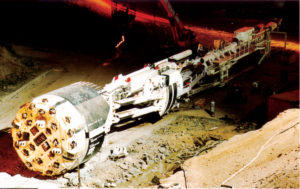![65 Years of Innovation and Experience [default]](https://www.robbinstbm.com/wp-content/uploads/2017/04/Side-Bar-Blue-Blocks_70-Years.jpg)
A Solution for Every Condition: Search our Project Database
Project Map
FEATURED PRODUCT: CROSSOVER MACHINES
Our History
A Legacy of Innovation
Information 24/7
News & Media
Insights in the Industry:
Read the Robbins Blog
 The Lesotho Highlands Water Project, a cooperative effort between Lesotho and South Africa, seeks to rejuvenate South Africa’s heavily populated and arid Gaucheng Province. It’s first phase began in 1992 and involved construction of the 180 m (590.5 ft) high Katse Dam, part of the Orange (Sequ) River system in Lesotho. The dam, finished in 1998, supplies water to South Africa’s Vaal river system via a water transfer tunnel and two delivery tunnels.
The Lesotho Highlands Water Project, a cooperative effort between Lesotho and South Africa, seeks to rejuvenate South Africa’s heavily populated and arid Gaucheng Province. It’s first phase began in 1992 and involved construction of the 180 m (590.5 ft) high Katse Dam, part of the Orange (Sequ) River system in Lesotho. The dam, finished in 1998, supplies water to South Africa’s Vaal river system via a water transfer tunnel and two delivery tunnels.
The two countries awarded the construction contract to the Lesotho Highlands Project Contractors (LHPC), a joint venture of Spie Batignolles (France), LTA Ltd. (South Africa), Ed Zublin AG (Germany), Balfour Beatty Ltd. (U.K.) and Campenon Bernard (France).
In 1991, LHPC contracted The Robbins Company to supply three new tunnel boring machines (TBMs) for the longer water transfer tunnel and one rebuilt TBM for the delivery tunnel. Two other TBMs from Atlas Copco and Wirth also participated in the dig.
The route of the water transfer tunnel passes through basaltic flows of volcanic rock. The area also includes some blocky conditions along faults and within doleritic dykes.
The south delivery tunnel passes through sedimentary rock, including the Clarens formation. This formation consists of horizontally layered siltstone and sandstone with occasional doleritic dykes and layers of claystone.
Robbins supplied two new 5.03 m (16.5 ft) diameter Main Beam TBMs to excavate the 45.6 km (28.3 mi) water transfer tunnel. These machines were equipped with 35 disc cutters, all 17 inches (432 mm) in diameter. Both machines were designed with back-loading cutterheads which allowed for later installation of 19 inch (483mm) diameter cutters. The TBMs featured five 315 kW (422 hp) water-cooled motors that supplied 1,575 kW (2,111 hp) to the cutterhead.
An additional 5.18 m (17.0 ft) diameter TBM was deployed on the south delivery tunnel after being refurbished by Harrison Western Corp. The refitted Main Beam TBM featured 37 cutters all 17 inches (432mm) in diameter. The machine was powered by six 185 kW (248 hp) motors that provided 1,110 kW (1,489 hp) to the cutterhead.
Robbins built the 5.0 m (16.4 ft) diameter Mark-15, an open hard rock TBM, with 4 center cutters, 22 face cutters, and 8 gauge cutters, all 17 inches (432 mm) in diameter. Three 560 kW (751 hp) motors supplied 1,680 kW (2,253 hp) to the cutterhead and produced a torque of 1,588 kNm (1,171,523 lb-ft).
All four of the TBMs supplied were equipped with rock drill and trailing back-up systems.
 The first Main Beam TBM began boring the 17.4 km (10.8 mi) transfer tunnel section in June 1992 and set world tunneling records for its diameter class. It achieved a best day of 86.3 m (283.1 ft), a best week of 399.8 m (1,311.7 ft), and a best month of 1,344.3 m (4,410.4 ft). The TBM set these records despite challenging geology along the tunnel route. Rock jointing necessitated rock support measures, especially at the beginning of the drive. This support took up 24 percent of the total job time. The machine’s average rate of penetration was 4.59 m (15.1 ft) per hour and its average advance rate was 33.4 m (109.6 ft) per day. It broke through in September 1994.
The first Main Beam TBM began boring the 17.4 km (10.8 mi) transfer tunnel section in June 1992 and set world tunneling records for its diameter class. It achieved a best day of 86.3 m (283.1 ft), a best week of 399.8 m (1,311.7 ft), and a best month of 1,344.3 m (4,410.4 ft). The TBM set these records despite challenging geology along the tunnel route. Rock jointing necessitated rock support measures, especially at the beginning of the drive. This support took up 24 percent of the total job time. The machine’s average rate of penetration was 4.59 m (15.1 ft) per hour and its average advance rate was 33.4 m (109.6 ft) per day. It broke through in September 1994.
The second Main Beam TBM began its 17.3 km (10.7 mi) drive in July 1992. It achieved an average rate of penetration of 4.1 m (13.5 ft) per hour while maintaining average advance rates of 27.6 m (90.6 ft) per day and 620 m (2,034 ft) per month. The TBM turned in a superior performance with a best day advance of 66.8m (219.2 ft), a best week of 325 m (1,066 ft) and a best month of 1,221 m (4,006 ft).
The Mark 15 also began boring the water transfer tunnel in May 1992 and achieved breakthrough in September 1994. Difficult rock conditions slowed the boring and decreased the machine’s advance rate. Its best day was 62.9 m (206.4 ft), its average rate of penetration was 3.9 m (12.8 ft) per hour, its best week was 289 m (948 ft), and its best month was 987 m (3,238 ft). Rock support (i.e., bolting, rock straps, mesh, and concrete) took up about 15 percent of the total job time.
On October 13, 1994, the final Robbins TBM broke through ventilation shaft #3, completing excavation of the water transfer tunnel.
The refurbished Main beam TBM for the south delivery tunnel began boring in February 1992 and broke through 20 months ahead of schedule in August 1993. The TBM attained this feat in three drives of 2.1 km (1.3 mi), 5.2 km (3.2 mi), and 5.7 km (3.5 mi). Its average rate of penetration was 3.86 m (12.7 ft) per hour or 39.9 m (130.9 ft) per day (in three eight-hour shifts). The best day for the machine was 82 m (269 ft), the best week was 384 m (1,259.8 ft), and the best month was 1,324.4 m (4,345.1 ft).

 Close
Close